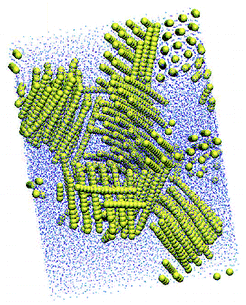Abstract
Addition of nanoparticles to polymer melts can significantly alter the mechanical properties of the resulting composite systems. Here we address the influence of nanorods on nanocomposite behavior and, in particular, on the entanglement network of the composites through extensive Monte Carlo and molecular dynamics simulations at equilibrium and under uniaxial deformation. Recently proposed topological algorithms are used to determine the primitive path network and the entanglement molecular weight of polymer−rod composites. A systematic study is presented of the effects of particle size, aspect ratio and volume fraction on their structure and entanglement state. For the primitive path analysis we consider two physical cases: the “frozen particle limit” where nanoparticles with fixed coordinates are explicitly present in the minimization process for the extraction of the primitive path network, and the “phantom particle limit” where nanoparticles are removed prior to the entanglement analysis. Simulation results indicate that the inclusion of nanoparticles into the polymer matrix does not significantly alter the polymer−polymer primitive path network. Instead, it enriches the nanocomposite system by nucleating additional topological constraints of polymer−particle origin.
